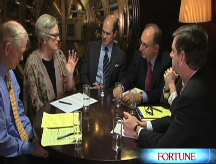'Wanted: Bank failure specialist'
The FDIC is looking to hire about 125 new workers in order to cope with more bank turmoil in 2009. Starting salary? $156,000 per year.
NEW YORK (CNNMoney.com) -- Hardly a day goes by without an announcement from a big company taking an axe to its payroll. But guess who won't be laying off people anytime soon?
The Federal Deposit Insurance Corporation.
Faced with what the likelihood of even more bank failures in 2009, the nation's top banking regulator has ramped up its hiring in recent weeks.
Over the next three months, the agency plans to add about 125 new employees, according to a FDIC spokesman. The majority of those positions are aimed at dealing with struggling or failed institutions in Western states.
Nearly all of those workers will be headquartered out of Irvine, Calif. Last month, the FDIC announced it had signed a three-year lease on a 200,000 square-foot building there, representing its first temporary satellite office in more than a decade.
"[The FDIC is] fully expecting, over the course of the next 12 to 18 months, [that] there is going to be a rash of failures," said Nick Ketcha Jr., a former director of supervision at the FDIC who now serves as a managing director at the New Jersey-based financial services consulting firm FinPro.
Bank failures have climbed in recent months as the industry continues to grapple with a myriad of problems, including rising mortgage delinquencies and a deterioration in the quality of banks' credit card portfolios.
Twenty-three banks have failed so far this year. The most recent collapse was First Georgia Community Bank, which was placed into receivership by the FDIC last Friday.
With the economy in a full-blown recession that shows no sign of relenting, industry observers are bracing for more failures to follow as hard-hit banks try to keep up with loan losses.
John Douglas, a partner at the law firm Paul Hastings and former general counsel at the FDIC who served during the height of the savings and loan crisis of the late 1980s and early 1990s, warned that easily 200 banks, if not more, could fail in the next two years.
The FDIC has hinted at more failures as well. It estimates that the deposit insurance fund, which is used to cover deposits when a bank fails, will suffer about $40 billion in losses through 2013. Last summer's collapse of the California-based mortgage lender IndyMac wiped out $8.9 billion from the fund.
Experts are quick to point out, however, that the number of failures are unlikely to approach the more than 1,000 institutions that failed during the S&L crisis.
What is distinctly different this time around is that banks were better capitalized and did not to hold many mortgages on their books, instead selling them to entities like government-controlled mortgage financing firms Freddie Mac and Fannie Mae.
"Nowadays a lot of the exposure is spread out in a lot of different places," said Douglas. "That's good and bad, but at least for the banking industry that's on the good side."
Of the more than 8,400 banks that the FDIC covers, only a small fraction are currently on the agency's watch list for potential failure. There were 171 institutions on its so-called 'problem bank' list as of the end of the third quarter .
That is the highest level since 1995. In the second quarter, 117 banks were on the list.
But many have wondered whether the problem list is an accurate picture of the health of the nation's banking sector.
A survey of nearly 1,300 chief financial officers released Wednesday by Duke University revealed that 75% had fundamental concerns about the health of the financial institutions they do business with and that more banks should be on the problem list.
"CFOs' concerns suggest this is at best a low-ball number, and at worst highly unrepresentative of the health of American financial institutions," said Campbell Harvey, a professor of finance at Duke's Fuqua School of Business.
The FDIC has maintained in recent quarters that it expects the number to climb and pointed out that the problem bank list is a lagging indicator.
At the same time, most banks on the problem list never actually reach the point of collapse.
"The problem bank list is not a barometer of the health of the banking industry," the agency said in a statement.
Still, it looks like "resolution or receivership specialists", workers who are well-versed in bank failure procedures, are at the top of the FDIC's wish-list for hires.
Such positions typically last for two years or more, and come with a salary of as much as $156,000, according to postings on the FDIC Web site. A "resolution and closings manager" is eligible for of annual salary of nearly $178,000.
With the banking and financial industry continuing to hemorrhage jobs at an alarming rate, there is a deep pool of talent for the FDIC to draw from.
But experts note that in all likelihood, many of the available jobs at the agency will go to former or existing FDIC employees or employees of failed institutions.
If the latest hiring trend bears out, the banking regulator could boast more than 5,000 workers by early next year. At last count, the agency's workforce numbered just over 4,600.
It remains unclear, however, just how much the FDIC wants to expand beyond that level.
The agency said there are no plans at this time to open any other temporary locations around the country to cope with future failures. Typically, all failed bank activity is handled out of the FDIC's Dallas regional office.
At the same time, there is no indication how big of a budget the agency is requesting for 2009. Last year, the FDIC had an annual budget of nearly $1.2 billion. Its board is scheduled to vote on the matter later this month. ![]()



